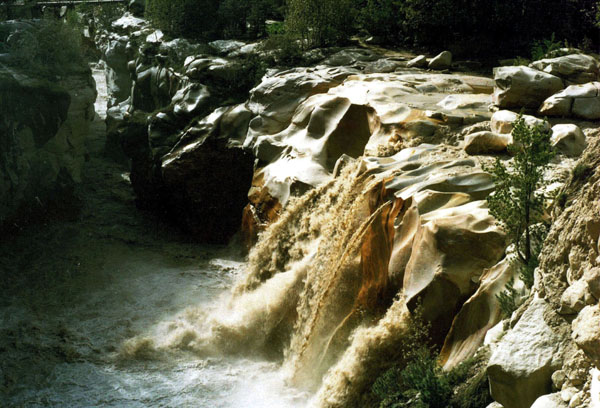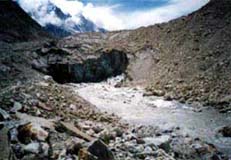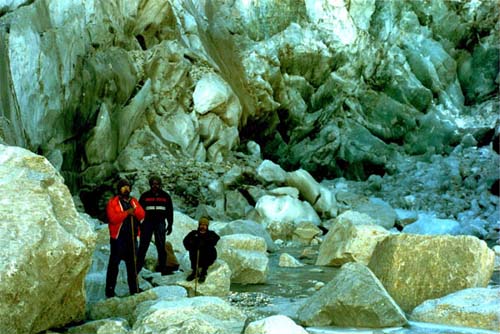Oct 19, 2025
Oct 19, 2025
Gangotri the revered religious place of the Hindus and source of the holy Ganges is often in the news. Many times news caption reads, 'Gangotri in peril, will Ganga dry up?' Naturally such news stirs lots of minds. People start imagining Gangotri glacier to be a large refrigerator where ice has started to melt and soon there won't be any! Wish it was a refrigerator, we could have got it repaired and ice would have been formed again!

Image of Suryakunda in Gangotri.
Alas, the natural processes are not that simple. And it is also true that nature does not change things over night. There are set parameters for everything. But yes human intervention in the form of hacking of trees on a large scale and industrialization has certainly stressed the nature to behave in an unnatural way at times. Religious sentiments apart, what is Gangotri glacier and what is happening inside it, is it really going to melt like a ice in the fridge or is it going to be around for the time being are the questions that perplex the common mind.
Like a river, the Gangotri glacier has three main tributaries, viz. Raktvarn (15.90km), Chaturangi (including Kalindi bamak) (22.45km) and Kirti (11.05 km). In addition there are more than 18 smaller tributary glaciers. Raktvarn is a system of seven tributary glaciers of which Thelu, Swetvarn, Nilambar and Pilapani are the significant ones. The Chaturangi group of glaciers has Seeta, Suralaya and Vasuki glaciers as tributaries. Similarly the Kirti system includes three tributary glaciers. Besides these three major tributary systems there are other tributary glaciers that drain directly in to Gangotri glacier, among them Swachand, Miandi, Sumeru and Ghanohim are important.
We are in an interglacial phase of the earth. That is the warm phase between two Ice Ages. Therefore, unlike a river the present day glaciers move upstream, in other words they retreat.

Snout of Gangotri in 1971 Snout of Gangotri in 2005
Image courtesy Geological Survey Of India Chief Editor, Current Science
Quoting NASA's studies jointly carried out with United States Geological Survey (USGS) and the National Snow Ice and Data Center (NSIDC), the Wikipedia says that Gangotri glacier has been retreating constantly since 1780. Over the last 25 years it has retreated more than 850 metres, including a retreat of 76 m between 1996 and 1999, compared to two kilometer over the last 200 years.
Kireet Kumar, Rakesh K. Dumka, M.S. Miral, G.S. Satyal and M. Pant scientists from the G.B. Pant Institute of Himalayan Environment and Development, Almora, Uttrakhand, using the latest techniques of GPS surveys have come out with report that the Glacier is no doubt retreating but not at a rate as hyped by many of the researchers.
The Himalaya are the potent source of water with about 1400 cubic km of snow and ice locked in as glaciers spread over an area of nearly 33,200 sq. km area at 4300-5800 m above sea level (asl) report Kireet and his colleagues. Himalayan glaciers have been there since past 1.75 million years. However, since past 18000 years they have been receding globally. The Himalayan glaciers are no exception.
Apart from being a potent source of water, the glaciers are also one of the most reliable repositories of information about the past climates. They have been there since much before we came around they have been witness to all the climatic vicissitudes.
Gangotri glacier and the river Ganga emerging out of it has been a center of attraction since times immemorial. Not only the Hindus but even the British were fascinated by them. That is why Major James Rennel a Surveyor with the East India Company wrote in his book, 'Memoir of a map of Hindoostan' in 1783 'the mouth of the cave from which the Ganga emerges from the Gangotri area is believed by the Hindoos to resemble the shape of a cow's forehead head'.

This is Gaumukh. Unfortunately, it no longer looks like Gaumukh
' 'a cow's face'. Massive ice chunks lie scattered.
The snout and the adjacent area of the glacier often crack.
' Indrajit Bandyopadhyay (From Trek to Tapovan)
However, the curiosity continued with the British. Captain Web and in 1808 and James Belie Fraser in 1815 did reach Gangotri but they could not locate the source of Ganga the 'Gaumukh'. Hence they pooh-poohed the Hindu belief as a figment of imagination only. Finally on 31st May 1817 Captain Hodgson managed to locate the cave, the source of the River Ganga. It appeared like a cow's forehead to him. Griesbach, a geologist with Geological Survey Of India (GSI) not only managed to reach Gangotri but and also prepared a sketch of the snout in 1891. J.B Auden again of GSI prepared the first detailed geological map of Gaumukh and surrounding areas in 1935. This map forms a base for all surveys even today. In the post Independence period Bala Singh Jangpangi and Amber Prasad Tewari of GSI carried out pioneering surveys of the glacier in 1956 and 1967 respectively.
Gangotri glacier is 30.20 km long with an average width of 1.50 km and has 28.72 cubic kilometer ice.
Like a river a glacier too is always on the move. Only difference is that the motion of a river is perceptible and it flows down the slope whereas, a glacier retreats at an imperceptible pace. J.B. Auden had estimated with the help of glacial deposits left by the retreating Gangotri glacier that in past one century the glacier had retreated by 2400 feet. Later surveys by GSI indicated that during the period from 1956 to 2001 it had retreated at variable rates of 10.16 m per year to 26.5 m per year in the last 50 years. Maximum retreat of 38.00 m the glacier was recorded in the year 1975-76. The retreat continues, it is a normal phenomenon. Today the location of Gaumukh is at 4000 m 17 km further up from Gangotri Temple. However, the geomorphology of the area tells a different story. In the geological past it was further ten kilometer down at Jangla.
Gangotri is not merely a glacier of religious significance. It is a glacier that has been under constant monitoring of GSI. A report published by Dr. Deepak Srivastava, Deputy Director General and an eminent Glaciologist in 2003 records past observations as enumerated here under:
|
Period |
Annual Snout Retreat (m) |
Reference |
|
1935-1956 |
4.35 (small cave) |
Vohra and Jangpangi (1956) |
|
1956-1971 |
27.33 |
Vohra (1971) |
|
10971-1974 |
27.34 |
Puri and Singh (1974) |
|
1974-1975 |
35.00 |
Puri (1975) |
|
1975-1976 |
38.00 |
Puri (1976) |
|
1976-1977 |
30.00 |
Puri (1977) |
|
1977-1990 |
28.08 |
Puri (1990) |
|
1990-1996 |
28.33 |
Sangewar (1996) |
It is significant to know that GSI's reports are based on actual physical survey of the snout.
In the past 1.75 million year history of the earth, there have been cold and warm climatic phases. During the cooling phase there has been massive glaciation. It can be visualized from the fact that the glacier was 27 km longer than what it is today towards the end of the glacial phase. In the geological history of the earth there have been inter-glacial phases between two ice ages. At present the earth is passing through an inter-glacial phase. Thus there is a worldwide recession of glaciers. Whether this retreat is due to rise in average annual surface temperatures of the globe is yet to be established.
The recession rate of the glaciers is indirectly dependent upon the mass balance of the glacier. In other words it takes in to account the annual accumulation of snow during winter and ablation (melting) during summer.
In order to measure the total recession Kireet and his colleagues used global positioning system (GPS) to estimate the precise recession rates. With the help of traces left by the retreating glacier on the surface and also with the help of earlier base maps Kireet and his colleagues found that the glacier has retreated by 1519.13 m in the last 69 years. In the period after 1971 they state that the glacier has retreated at a much lower rate and monitoring of retreat for the year 2004-2005 revealed that total recession was only 12.10'0.041 ma-1. The recession along the centre line of the glacier was slightly higher at 13.76 ' 0.048 m they inform.
As apparent the figures quoted by different scientific agencies vary. But the glaciologists who are involved with the mass balance studies of Gangotri glacier seem to be unperturbed. They say that the retreat is normal and one should not get alarmed with the annual variations of the rate of melting. Winters with heavy snowfall add to the glacial ice. For example during the period November 2007 till mid February 2008 there has been a heavy snowfall in the higher reaches of the Himalayas. Thus the figures of mass balance for the year 2007-2008 when worked out will certainly show a positive balance.
It is apparent that Gangotri glacier is retreating, but it is not yet in a perilous state. Natural retreat of a glacier can not be stopped, yet in order not to stress the glacial environment anthropogenic intervention with nature in the form of hacking of forests, throngs of tourists littering the glacier body and the snout etc must be avoided.
Perhaps our ancestors knew it better! That is why all such natural bodies were treated with reverence.
09-Mar-2008
More by : V. K. Joshi (Bijji)